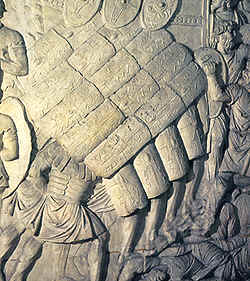The Roman Army was considered the most advanced of its time. The Roman Army created the Roman Empire – a huge part of Western Europe – and Rome itself greatly benefited from the riches that the army brought back from its conquered territories.
The Roman Army developed fighting techniques that were linked to a ferocious training regime. All new recruits to the army became very fit and disciplined. Training was harsh, as were punishments for failure. In a battle, new recruits were always placed at the front of the more experienced soldiers in the army. There were three reasons for this. The first was to give them confidence as behind them were experienced soldiers who had fought in battles before. Secondly, it stopped the new soldiers running away if their courage deserted them. Finally, those who were more likely to be killed in the initial phase of a battle were at the front. The hardened and experienced legionnaires were at the rear. The Roman Army could ill afford to lose experienced legionnaires whereas if a new legionnaire came through a battle alive, he would be blooded and experienced and a valuable addition to the army. If he was killed, then the loss of his inexperience would not be too great.
The most important fighting unit of the Roman Army was the legion commanded by a legatus. This consisted of between 5000 to 6000 legionnaires. 500 to 600 legionnaires made up a cohort while between 80 to 100 soldiers were a century commanded by a centurion.
The Romans used a tried and tested attacking technique. Legionnaires would run forward at the enemy and throw their pila at them. While this caused disarray among the enemy, the legionnaires would move in for close quarter fighting using their swords (gladius). Each attack was the result of meticulous planning and practice – hence why they were usually so successful.
To support the legionnaires, the Romans also used cavalry. The primary task of the cavalry was to support the legionnaires by attacking an enemy line at the flanks. Cavalry was also used to chase after a retreating enemy.
To assist the legionnaires, who were professional soldiers, part-time soldiers were used called auxiliaries. These men were often recruited from an area that the Romans were trying to conquer and occupy. They were not fully trained soldiers and their usual task was not to fight when the legionnaires attacked, but to assist them by acting as scouts or archers who would fire at the enemy while the legionnaires attacked. Those auxiliaries who fought on foot would be used to attack an enemy position before the legionnaires did – in this way, an enemy position would be softened up before the main assault.
Fortifications presented other challenges. When confronted with a fort or the like, a frontal assault by legionnaires would have resulted in large casualties, though the use of a ‘tortoise’ would have helped reduce casualties.
|
The ‘tortoise’ in action |
The Romans designed weaponry that both gave some protection to their men but also were designed to smash into fortifications. Battering rams and siege towers were used for this – the latter allowed the Romans to gain access to a fort by effectively removing the problem of a high wall. Battering rams had a cover to them made of wood and animal hide. This combination was enough to stop arrows etc but was still flammable.
The Romans also developed an early form of large attack catapults called onagers. These hurled large stone boulders at a wall to smash it down. The Romans also used catapults to fire iron bolts at the lines of the enemy facing them.
All of this required meticulous training and one of the most important people involved here were the centurions. Each centurion was required to ensure that his century was a capable and effective fighting force. Any century that did not perform well in battle might pay the price and be ‘decimated’. The unit would stand in line and every tenth man would be taken out and killed. This was known as ‘decimus’ by the Romans. This punishment served as a stark warning to the other units and to those who had survived in the century being punished.
